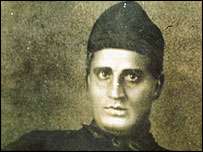Radhanath Sikdar
Radhanath Sikdar (Bengali: রাধানাথ শিকদার; October 1813 – 17 May 1870) was an Indian Bengali mathematician who is best known for calculating the height of Mount Everest.
Radhanath Sikdar | |
|---|---|
 Radhanath Sikdar | |
| Born | Oct 1813 |
| Died | 17 May 1870 |
| Occupation | Mathematician |
| Known for | Calculated height of Mount Everest |
| Parent(s) | Tituram Sikdar(Father)[1] |
Great Trigonometric Survey
When, in 1831, the Surveyor General of India George Everest was searching for a brilliant young mathematician with particular proficiency in spherical trigonometry, the Hindu College maths teacher John Tytler recommended his pupil Sikdar, then only 19. Sikdar joined the Great Trigonometric Survey in 1831 December as a "computer" at a salary of thirty rupees per month. Soon he was sent to Sironj near Dehradun where he excelled in geodetic surveying. Apart from mastering the usual geodetic processes, he invented quite a few of his own. Everest was extremely impressed by his performance, so much so that when Sikdar wanted to leave GTS and be a Deputy Collector, Everest intervened, proclaiming that no government officer can change over to another department without the approval of his boss. Everest retired in 1843 and Col. Andrew Scott Waugh became the Director.
After 20 years in the north, Sikdar was transferred to Calcutta in 1851 as the Chief Computer. Here apart from his duties of the GTS, he also served as the Superintendent of the Meteorological department. Here he introduced quite a few innovations that were to remain as standard procedures for many decades to come. The most notable was the formula for conversion of barometric readings taken at different temperatures to 32 degrees Fahrenheit.[2]
At the order of Colonel Waugh, he started measuring the snow-capped mountains near Darjeeling. Compiling data about Peak XV from six different observations, he eventually came to the conclusion the Peak XV was the tallest in the world. He gave a full report to Waugh who was cautious enough not to announce this discovery before checking with other data. When after some years, he was convinced, only then did he publicly announce the same. The norm, strictly followed by Everest himself, was that while naming a peak, the local name should be preferred. But in this case, Waugh made an exception and paid a tribute to his predecessor.[3][4]
Other
It appears that while Everest and Waugh both extolled him for his exceptional mathematical abilities, his relations with the colonial administration were far from cordial. Two specific instances are on record.
In 1851 a voluminous Survey Manual (Eds. Capt. H. L. Thullier and Capt. F. Smyth) was published by the Survey Department. The preface to the Manual clearly and specifically mentioned that the more technical and mathematical chapters of the Manual were written by Babu Radhanath Sikdar. The Manual proved to be immensely useful to surveyors. However, the third edition, published in 1875 (i.e., after Sikdar's death) did not contain that preface, so that Sikdar's memorable contribution was de-recognized. The incident was condemned by a section of British surveyors. The paper Friend of India in 1876 called it 'robbery of the dead'.[5]
It is also on record that Sikdar was fined a sum of 200 rupees in 1843 for having vehemently protested against the unlawful exploitation of survey department workers by the Magistrate Vansittart. The incident was reported in detail in The Bengal Spectator edited by Ramgopal Ghosh.[5]
In 1854, Sikdar along with his Derozian friend Peary Chand Mitra started the Bengali journal Masik Patrika, for the education and empowerment of women. He used to write in a simple and uncluttered style that was rather atypical for the age.[6]
Sikdar had retired from service in 1862, and was later appointed as teacher of mathematics at the General Assembly's Institution (now Scottish Church College).[7][8]
He died on 17 May 1870 at Gondalpara, Chandannagar, in his villa by the side of the Ganga.
Recognition
In recognition of Sikdar's mathematical genius, the German Philosophical Society made him a Corresponding Member in 1864, a very rare honour.[9]
The Department of Posts, Government of India, launched a postal stamp on 27 June 2004, commemorating the establishment of the Great Trigonometric Survey in Chennai, India on 10 April 1802. The stamps feature Radhanath Sikdar and Nain Singh, two significant contributors to society. The Great Arc refers to the systematic exploration and recording of the entire topography of the Indian subcontinent which was spearheaded by the Great Trigonometric Survey.
Notes
- http://www.scienceandculture-isna.org/may-june-2014/05%20Art_Radhanath%20Sikdar%20First%20Scientist...by_Utpal%20Mukhopadhyay_Pg.142.pdf
- See 'Arya Darshan', 1884, Ed. Jogendranath Bandyopadhyay Vidyabhushan; Ajana Chaudhury, 'A Brief Historical Review of Early Weather Work in Kolkata', Psyche and Society, May 2009.
- See report in 'The Illustrated London News', 15 August 1857
- Ram Copal Sanyal, ed. (1894), Reminiscences and anecdotes of great men of India: both official and non-official for the last one hundred years, p. 25
- For details, see Ashish Lahiri, Radhanath Sikdar: Beyond the Peak, Boi-Chitra, Kolkata, 2010.
- See Sivanath Sastri, "Ramatanu Lahiri o Tatkalin BangaSamaj", 1904
- Hasnat, Abul. "Shikder, Radhanath". Banglapedia. Retrieved 26 July 2015.
- Staff List: General Assembly's Institution (1856-1907) in 175th Year Commemoration Volume. Scottish Church College, April 2008. page 569
- See Deepak Kumar, Patterns of Colonial Science in India, Indian Journal of History of Science, 15(1), May 1980.
References
- The Illustrated London News, 15 August 1857
- Bagal, Jogesh Chandra Unabingsha Shatabdir Bangla, 1941
- Shastri, Sivanath Ramatanu Lahiri o Tatkalin Bangasamaj, 1904
- Chaudhury, Ajana, R R Kelkar and A. K. Sen Sarma, Technology: Through the haze of time & neglect, The Statesman, Kolkata, 1 March 2009.
- Chaudhury, Ajana A Brief Historical Review of Early Weather Work in Kolkata, Psyche and Society, Kolkata, May 2009
- Lahiri, Ashish Radhanath Sikdar: Beyond the Peak, Boi-Chitra, Kolkata, 2010.
- Nath, Dr. Sankar Kumar Radhanath Sikdar: Taththeyer Aaloye, Chirayata, Kolkata-73, October 2012